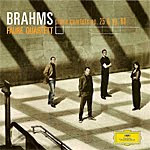By John J. Puccio

Here are a few of my absolute favorite classical recordings (listed alphabetically), which the reader may find of interest. They are major, basic-repertoire, warhorse items to be sure. There is a reason why great music is great music, after all, and to have chosen a handful of obscure, esoteric works as personal favorites would have seemed to me pretentious and dishonest. The hard part, of course, was narrowing down the list from thousands of favorites to a precious few, but I did my best.
Incidentally, because I value these recordings so much, I own most of them in somewhat hard-to-get and relatively expensive Japanese and German remasterings, but for the purpose of this list I have indicated their availability in domestic releases. For those buyers adventurous enough (and with deep-enough pockets), I suggest trying Amazon Japan, Amazon France, Amazon Germany, Amazon England, and the HMV Shop, Japan. They stock almost everything, but shipping, especially from Amazon Japan, can be a jolt.
Beethoven: Symphony No. 6 "Pastoral" (Bohm, Vienna Philharmonic O.) DG
The problem I had here was deciding which of several different recordings of the "Pastoral Symphony" I liked best. The other contenders--Fritz Reiner, Bruno Walter, Otto Klemperer, and Eugene Jochum--made the choice tough, but I went finally with Bohm's gentle, genial approach.
Berlioz: Symphonie fantastique (Beecham, French National Radio O.) EMI
No one conveys the spirit, the color, and the humor of this work better than Sir Thomas Beecham.
Chopin: Piano Concerto No. 1 (Pollini; Kletzki, Philharmonia O.) EMI
I alphabetized this list, but if I were pinned down to name my single most-favored disc in the world, it would probably be this one. Yeah, I'm a hopeless Romantic.
Chopin: Nocturnes (Rubinstein) RCA
Arthur Rubinstein was a master of Chopin. And while I also love individual Chopin pieces by Pollini, Cliburn, and others, it is Rubinstein who excelled in all areas Chopin. His two-disc set of the complete
Nocturnes may seem overly cool, calculated, or precise to some ears and impossibly Romantic to others; to me, however, it sounds just right, and in RCA's latest remastering, it sounds sonically impressive as well.
Debussy: La Mer (Stokowski) HDTT
Leopold Stokowski's 1970 Decca recording of
La Mer with the LSO has been a favorite of mine for decades, but it wasn't until HDTT (High Definition Tape Transfers) remastered it that I finally heard it as the old maestro meant it to be heard. It's still not the most-natural sound in the world, but it's close enough, and it enhances what is already a commanding performance.
Dvorak: Symphony No. 9 "From the New World" (Kertesz, London Symphony O.) Decca
Istvan Kertesz recorded the Dvorak
Ninth a few years earlier in his career for Decca and did it very well, but this later one is even more mature and more spellbinding.
Giuliani: Guitar Concerto No. 1 (Romero; Marriner, Academy of St. Martin in the Fields) Philips
For a terrific pick-me-up, this delightful little concerto is just the thing, and no one has done it up better than Pepe Romero, with Marriner and the Academy.
Handel: Water Music (Nicholas McGegan, Philharmonia Baroque Orchestra) Harmonia Mundi
Everyone has to have a copy of Handel's most-famous orchestral music in their collection, and for me there is none finer than McGegan's recording with the Philharmonia Baroque played on period instruments.
Haydn: Symphony No. 100 "Military" (Jochum, London Philharmonic O.) DG
I believe you may only find this recording on CD in the complete set of Jochum's Haydn "London Symphonies," but the whole set is worth the money in any case.
Holst: The Planets (Previn, London Symphony O.) Hi-Q or EMI
This has long been an audiophile demo piece for me, and it remains so.
Ketelbey: In a Monastery Garden (Lanchbery, Philharmonia O.) EMI
In the silent days of Hollywood, filmmakers loved to recommend Ketelbey's music to accompany their movies. It's pure schmaltz and wonderful listening.
Lehar: The Merry Widow (Schwarzkopf; Matacic, Philharmonia O.) EMI
One of the most-charming operettas ever written, filled with light, frothy tunes, perfectly captured by Elizabeth Schwarzkopf and company in this classic set.
Mahler: Symphony No. 9 (Barbirolli, Berlin Philharmonic O.) HDTT or EMI
The Mahler
Ninth was probably Sir John Barbirolli's best recording ever with the Berlin Philharmonic, and it's ravishing all the way around.
Massenet: Le Cid, ballet music (Fremaux, City of Birmingham Symphony O.) EMI or Klavier
Really fun stuff in outstanding sound. However, the disc may be a bit hard to get anymore.
Mendelssohn: A Midsummer Night's Dream (Klemperer, Philharmonia O.) EMI or EMI Japan
Some classical-music listeners tend to think of Otto Klemperer as a rather dour, straightlaced conductor, but one listen to this delicate, light-as-a-feather performance will prove otherwise.
Mozart: The Marriage of Figaro (Taddei, Moffo; Guilini, Philharmonia O.) EMI
I don't know that anyone has matched Carlo Maria Giulini in Mozart opera interpretations. It's maybe the only opera I can listen to straight through in a single sitting.
Mozart: Symphony No. 41 "Jupiter" (Jochum, Boston Symphony O.) DG
When DG issued Eugene Jochum's Mozart "Jupiter"
Symphony on LP in 1973, it went straight to the top of every critic's list of recommendations and stayed there for years. What's more, it's coupled with probably the best Schubert "Unfinished"
Symphony ever recorded, making it a must-buy. Yet as of this writing DG have never released it on CD in America. Astonishing. If you're interested, the disc is available from Germany (in a lovely little Digipak that duplicates in miniature the original album cover).
Paganini: Violin Concerto No. 1 (Rabin; Goossens, Philharmonia O.) EMI set, EMI France set, or EMI Japan
Here's another major studio oversight. Michael Rabin's performance of Paganini's
Violin Concerto is the liveliest, peppiest, zippiest, most-frolicsome you'll find anywhere, yet EMI (now Warner Classics) offer it only in a big box set of Rabin's work, not as a single disc. If you want it otherwise, you'll find it on a two-disc French EMI import and on a single disc from EMI Japan.
Puccini: La Boheme (Freni, Pavarotti; Karajan, Berlin Philharmonic O.) Decca
Practically everybody's favorite opera, with everybody's favorite singers. What more could a person want?
Rachmaninov: Symphony No. 2 (Previn, London Symphony O.) EMI or EMI Japan
I told you I was a hopeless Romantic, and what symphonic music could be more Romantic than Rachmaninov's
Second Symphony, which Previn nails perfectly in what is still state-of-the-art sound.
Rimsky-Korsakov: Scheherazade (Reiner, Chicago Symphony O.) RCA or JVC
Spectacular, whiz-bang sonics from, amazingly, over half a century ago! Great performance, too.
Rodrigo: Concierto de Aranjuez (Yepes; Argenta, Spanish National Orchestra) HDTT
I loved this recording when I was younger, and I love it today. Thank goodness for HDTT for bringing it back to life sounding better than ever before.
Saint-Saens: Symphony No. 3 "Organ" (Fremaux, City of Birmingham Symphony O.) EMI or Klavier
Just let those big bass organ notes wash over you like gigantic ocean waves. This one will definitely give your subwoofer a workout, with Fremaux offering up the most-exciting interpretation the piece has ever received on disc. The EMI disc is readily available; the Klavier, with slightly more natural sound and stronger bass, is out of print and may be hard to find.
Schubert: Piano Quintet in A major "Trout" (Beaux Arts Trio et al) Philips or PentaTone
You can find this "Trout" in regular stereo on Philips or in multichannel on PentaTone. In either case, you will not find anyone doing up this enchanting music better than the augmented Beaux Arts Trio.
Smetana: Ma Vlast (Dorati/Concertgebouw O.) Philips or Newton Classics
As with all of these favorites, you'll come across other interpretations equally good, but this one with Antal Dorati and the Concertgebouw Orchestra strikes me as among the more rewarding.
Strauss, Richard: An Alpine Symphony (Kempe, Dresden Staatskapelle) EMI Japan
Not generally considered one of Richard Strauss's better works (too picture-postcard cute for some listeners), I find it the most pictorial of all his tone poems and endlessly entertaining, especially in the hands of Rudolf Kempe, either with the Royal Philharmonic or his later version here with the Dresden Staatskapelle. (The earlier recording sounds better recorded; the later one better performed.)
Stravinsky: The Firebird (Dorati, London Symphony O.) Mercury
Mercury's sound holds up remarkably well after all these years, and the performance is unmatched in the complete ballet.
Stravinsky: The Rite of Spring (Bernstein, New York Philharmonic) Sony
The folks at Sony finally remastered Bernstein's classic 1958 Columbia recording, and it sounds splendid. You'll find no better a recording of this familiar score.
Sullivan (with Gilbert): H.M.S. Pinafore (Godfrey, New Symphony O. of London and D'Oyly Carte) Decca
Probably the most fun music of the list, and again done up in well-aged state-of-the-art sound.
Tchaikovsky: Piano Concerto No. 1 (Cliburn; Kondrashin, RCA Symphony O.) JVC or RCA
This was the first recording of any complete classical work I ever bought (eighth grade, 1958). I must have been the first (maybe the only) eighth grader in the country to own it (I don't know what possessed me to buy it on the first day RCA released it; I must have read about it somewhere), and I have since bought it in half a dozen other formats, culminating in a JVC XRCD24 audiophile remastering. The regular RCA disc is still plenty good enough, though.
JJP
 Many small chamber works--quartets, quintets, and the like--remind me in tone and structure of miniature symphonies. None more so than the two quartets presented here, Brahms's Quartets Nos. 1 and 3 for Piano, Violin, Viola, and Cello. Although their four-movement construction obviously mimics larger-scale pieces, it's more a matter of Brahms's large-scale vision that tends to make me think of things symphonic. If Brahms had orchestrated these two works for full orchestra, they might have made splendid symphonies for him. In fact, Arnold Schoenberg in 1937 did transcribe the First Quartet for orchestra and humorously called it Brahms's "Fifth Symphony."
Many small chamber works--quartets, quintets, and the like--remind me in tone and structure of miniature symphonies. None more so than the two quartets presented here, Brahms's Quartets Nos. 1 and 3 for Piano, Violin, Viola, and Cello. Although their four-movement construction obviously mimics larger-scale pieces, it's more a matter of Brahms's large-scale vision that tends to make me think of things symphonic. If Brahms had orchestrated these two works for full orchestra, they might have made splendid symphonies for him. In fact, Arnold Schoenberg in 1937 did transcribe the First Quartet for orchestra and humorously called it Brahms's "Fifth Symphony."



























